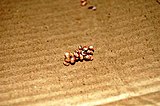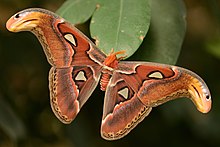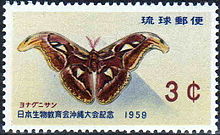How Long to Read Atlas of the World
| Atlas moth | |
|---|---|
 | |
| Female | |
| Scientific nomenclature | |
| Kingdom: | Animalia |
| Phylum: | Arthropoda |
| Class: | Insecta |
| Social club: | Lepidoptera |
| Family: | Saturniidae |
| Genus: | Attacus |
| Species: | A. atlas |
| Binomial name | |
| Attacus atlas (Linnaeus, 1758) | |
Attacus atlas , the Atlas moth, is a large saturniid moth endemic to the forests of Asia. The species was first described past Carl Linnaeus in his 1758 10th edition of Systema Naturae.
Description [edit]

Atlas moth compared to human hand

The Atlas moth is 1 of the largest lepidopterans, with a wingspan measuring up to 24 cm (9.four in)[1] and a wing surface area of almost 160 cmtwo (~25 in2).[2] It is merely surpassed in wingspan by the white witch (Thysania agrippina) and Attacus caesar,[1] and in wing surface expanse by the Hercules moth (Coscinocera hercules). As in well-nigh Lepidoptera, females are noticeably larger and heavier than males, while males have broader antennae.[three] [4] [v]
The body is disproportionately minor compared to the wings. The upperside of the wings are ruddy brown with a design of black, white, pinkish, and royal lines and triangular, scale-less windows bordered in black. The undersides of the wings are paler. Both forewings accept a prominent extension at the tip, with markings that resemble the caput of a ophidian, a resemblance which is exaggerated past movements of the wings when the moth is confronted by potential predators.[6]
The Atlas moth has a very brusk, vestigial proboscis, and they do not consume once they take emerged from the cocoon, relying on fat storage for free energy. Every flight takes valuable free energy and tin take days off their already short lives, equally it has a very curt life span of only one to two weeks.[seven] They conserve free energy by flying equally little as possible. A female will await for a male to come up along and be fertilised, lay eggs and dice.
Habitat [edit]

Their habitat is primarily dry tropical forests, secondary forests, and shrublands across Southward Asia, Eastern asia, and Southeast Asia, including Borneo, though one specimen, an developed female, was constitute in 2012 in Ramsbottom, England afterward information technology landed on a windowsill, and presumed to have escaped from a private collection.[eight] [nine]
Etymology [edit]
Atlas moths are named after Atlas, the Titan of Greek mythology (due to their size). In Hong Kong, the Cantonese means "snake'south head moth", referring to the prominent extension of the forewing which bears resemblance to the head of a snake.[10]
Life cycle [edit]
| Holometabolism (complete metamorphosis) | ||||
|---|---|---|---|---|
 |  |  |  |  |
| Eggs | Larva (3rd instar) | Pupa within cocoon | Emerging from pupa | Imago |
Mating [edit]
Females release powerful pheromones through a gland on the end of the abdomen to attract a mate. The female does not stray far from the location of her discarded cocoon. She seeks out a perch where the air currents will all-time carry her pheromones. Males can discover and home in on these pheromones from several kilometers away using chemoreceptors located on their feathery antennae.[11] Once fertilized, the female lays a number of spherical eggs, 2.5 mm (0.098 in) in bore, on the undersides of the leaves of food plants.
Larva [edit]
Dusty-green caterpillars hatch after approximately two weeks and feed voraciously on the leafage of citrus, cinnamon, guava, and evergreen trees.[12] The caterpillars tin abound to 11.5 cm (iv.5 in) in length and 2.v cm (0.98 in) in thickness. They are adorned with white, waxy, fleshy spines forth their backs, which become more than prominent at later instars. Beside the prolegs on the last abdominal segment, there is a large green spot surrounded by an orange ring. The bulk of the time their showtime meal is their egg-beat out.[13]
Pupa [edit]
After reaching a length of about 11.5 cm (4.five in), the caterpillars are ready to pupate. They spin a seven–eight cm long papery cocoon interwoven with desiccated leaves and attach it to a twig using a strand of silk. The developed moths emerge from the cocoon after approximately four weeks depending on ecology factors.
Imago [edit]

Adult Atlas moths are weak, unsteady fliers. To conserve energy, the moths residual during the day and fly at night. As they lack fully formed mouthparts, the adults cannot eat, subsisting entirely on fat reserves accumulated during the larval stage. Every bit a effect, they live for only a few days during which their sole objective is seeking out a mate. Adults may be constitute on fly throughout the year just are most arable between November and January[ citation needed ].
Relationship with humans [edit]

Japanese stamp featuring an Atlas moth
In Bharat, Atlas moths are cultivated for their silk in a non-commercial capacity. Unlike silk produced past the related domestic silkmoth (Bombyx mori), Atlas moth silk is secreted as broken strands and is therefore less desirable. This brown, wool-like silk, known equally fagara, is thought to have greater durability.[14] Atlas moth cocoons are sometimes used as small pocket change purses in Taiwan.[xv] At that place is ongoing research as to whether the silk of the Atlas moth tin can be used every bit a substitute for mutual silks. The quality of the heavier cocoons, less restrictive rearing conditions and competent properties of the fibers, makes the silk produced by the Atlas moth a potential culling for common silks. A study ended that the silk fibers of the atlas moth had nigh an eighty% higher density of cells and growth compared to the silk fibers of the silk moth.[xvi]
The Japanese subspecies A. a. ryukyuensis, native to Yonaguni in the Yaeyama Islands, may accept served as inspiration for the movie monster Mothra.
Similar taxa [edit]
The term "Atlas moth" is sometimes used mistakenly every bit a name for any species in the genus Attacus, of which there are over 20 named species and subspecies. Attacus taprobanis [17] native to southern India and Sri Lanka[xviii] is very similar in morphology to the much more widely distributed Attacus atlas. It was once considered a subspecies of A. atlas.[19] A few New World species can be mistaken for Atlas moths, specifically members of the genus Rothschildia. Very like in appearance to the Asian Atlas moth, Rothschildia aurota is one of the largest members of its genus and a Neotropical relative.
Encounter too [edit]
- List of largest insects
References [edit]
- ^ a b "Chapter 32: Largest Lepidopteran Fly Span | The University of Florida Volume of Insect Records | Department of Entomology & Nematology | UF/IFAS". entnemdept.ifas.ufl.edu.
- ^ "StackPath". australianbutterflies.com.
- ^ Watson, A. & Whalley, P.E.Southward. (1983). The Dictionary of Collywobbles and Moths in Colour. Peerage Books, London, England. ISBN 0-907408-62-ane
- ^ Robert M. Foottit & Peter H. Adler. 2009. Insect Biodiversity: Science and Society. Blackwell Publishing Ltd. ISBN 978-1-405-15142-9
- ^ Rainier Flindt. 2006. Amazing Numbers in Biological science. Springer-Verlag, Berlin. ISBN 3-540-30146-1
- ^ Howse, P.E. (2010) Butterflies: Letters From Psyche Papadakis, 192 pp. ISBN 978-1901092806
- ^ "Spotlight: the atlas moth". www.nhm.ac.uk . Retrieved 2019-08-21 .
- ^ Holloway, J.D. (1987). The Moths of Borneo, function 3: Lasiocampidae, Eupteroptidae, Bombycidae, Brahmaeidae, Saturniidae, Sphingidae. Southdene Sdn. Bhd., Kuala Lumpur
- ^ "Behemothic Atlas moth found on windowsill in Ramsbottom". BBC News . Retrieved 13 May 2020.
- ^ Yiu, Five. (2006). Insecta Hongkongica. Hong Kong Discovery. Kowloon, Hong Kong. 655pp. ISBN 988-97173-ix-5
- ^ Shepherd, Thousand.Grand. (1994). "Chemical Senses". In Neurobiology 3rd Edition. Oxford University Press
- ^ Robinson, 1000.S., Ackery, P.R., Kitching, I.J., Beccaloni, G.W. & Hernández, 50.M. (2001). Hostplants of the Moth and Butterfly Caterpillars of the Oriental Region. Southdene Sdn. Bhd., Kuala Lumpur & The Natural History Museum, London. 744 pp. ISBN 983-40053-3-4
- ^ Gosse, Philip Henry (1879). "The great Atlas moth of Asia (Attacus atlas, Linn.)". W, Newman & Visitor – via Gale Primary Sources.
- ^ Jolly, One thousand.S., Sen, South.Chiliad., Sonwalkar, T.N. & Prasad, G.Due south. (1979). Non-mulberry silks. Food & Agriculture Organization. United Nations, Serv. Balderdash. 29. Rome. xvii + 178pp
- ^ Due south. B. Jugale; et al. (2010). "Major Insect Pests of Xylocarpus granatum Koen., a Critically Endangered Mangrove Species of Maharashtra" (PDF). The Bioscan. Special Effect, Vol. 1: 257–268. ISSN 0973-7049.
- ^ Reddy, Narendra; Zhao, Yi; Yang, Yigi (2013). "Structure and Properties of Cocoons and Silk Fibers Produced by Attacus Atlas". Journal of Polymers and the Environs. 21: sixteen–23. doi:10.1007/s10924-012-0549-viii. S2CID 9466921 – via Science Citation Index.
{{cite journal}}: CS1 maint: multiple names: authors list (link) - ^ Moore, Frederic (1880). The Lepidoptera of Ceylon. Vol. II. London: 50. Reeve & co. pp. 124–125.
- ^ Peigler, Richard S. (1989). A Revision of the Indo-Australian Genus Attacus (Lepidoptera: Saturniidae). Lepidoptera Research Foundation. ISBN0961146427 . Retrieved 5 June 2018.
- ^ Savela, Markku. "Attacus atlas (Linnaeus, 1758)". Lepidoptera and Another Life Forms . Retrieved November 10, 2018.
External links [edit]
krogerreplads1943.blogspot.com
Source: https://en.wikipedia.org/wiki/Attacus_atlas
0 Response to "How Long to Read Atlas of the World"
Post a Comment